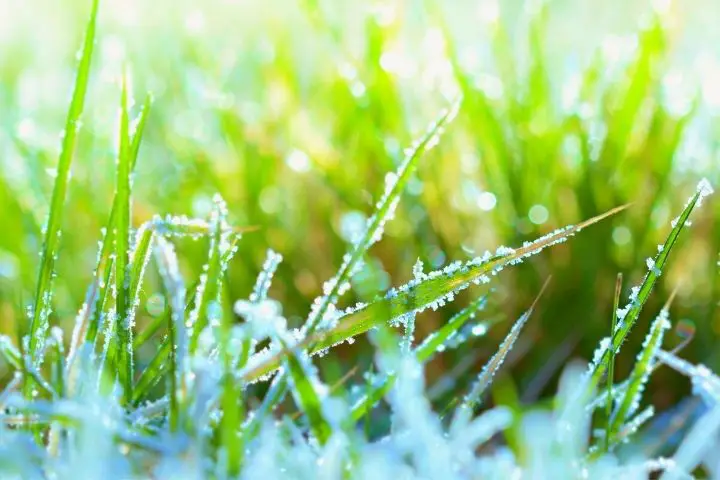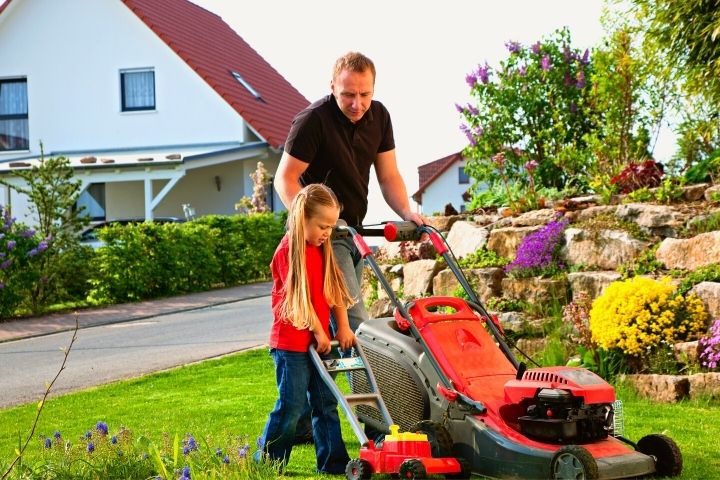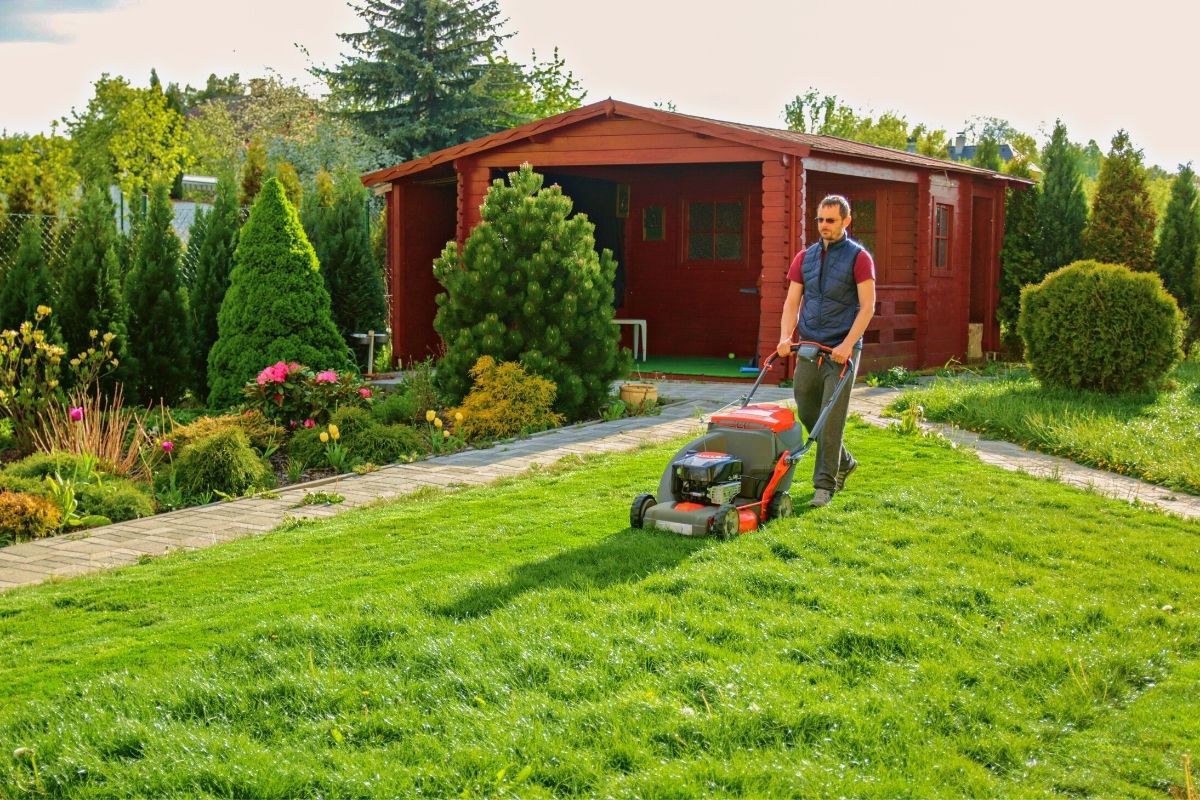Best Way to Mow Lawn After Frost (and get ready for spring)
We can all agree that there are pros and cons to keeping a turf lawn. But it’s a part of modern life that’s not going away anytime soon.
Learning how to care for your lawn properly can make day-to-day maintenance a little easier while also limiting the need for chemical fertilizers, herbicides, and other treatments.
For example, prepping your lawn for winter is key to producing healthy, self-sufficient growth the following spring. A big part of that preparation involves the how and when of mowing your lawn in the fall.
Mowing grass covered in frost is a big no-no. You can, however, safely mow grass after a frost as long as it has completely thawed.
Let’s take the mystery out of fall lawn care so you can lay the best groundwork possible for next year:
How Frost Affects Your Lawn
Frost is a subtle sign that winter is on the horizon. Yet it can have a surprisingly big impact on our lawns.
It’s fairly common knowledge that plants contain water — water is to a plant as blood is to our bodies. But it’s easy to forget that this water is just as susceptible to outdoor temperatures as any other kind.
Just like how a can of soda will expand when left in the freezer, the water inside grass expands when frozen. This puts a ton of stress on the plants’ cellular structure.
Grass will often bounce back from a light frost and continue growing if the weather remains mild. Once a deep or prolonged frost penetrates the soil, however, the blades will die off while the roots below the ground’s surface enter dormancy.

Can You Cut Grass With Frost On It?
Mowing with frost on the ground is never a good idea. Many experts advise against walking on frosty grass altogether!
It’s not the frost on the surface of your lawn that can cause serious damage. It’s the frozen water particles we mentioned above inside the grass that is problematic.
When a frozen blade of grass is stepped on or cut with a mower blade, the ice particles inside shatter. This can destroy the grass’s internal structure at the cellular level.
If you do need to mow your lawn following an early frost, you should wait until all of the frost has completely thawed. Once any visible frost is gone, give the grass a soft pat with your hand to ensure it is soft and pliable rather than frozen stiff before mowing.
Should You Mow Dormant Grass?
No, and there’s really no need to.
Grass (and eco-friendly lawn alternatives like clover) goes dormant when the environment is too harsh for it to continue growing healthily. Mowing your lawn during this time will put immense stress on the grass.
Remember that every time you mow your lawn you’re creating open wounds on each blade of grass. If you mow during dormancy, the grass must expend valuable energy to heal these wounds or risk rolling out a welcome mat to bacteria and fungi.
By the way, this advice doesn’t just apply to winter dormancy. It’s best to leave dormant grass untouched during summer droughts, as well.

When To Stop Mowing Lawn In Fall
A few factors determine when you should stop mowing your lawn each year. But, as a general rule, it’s safe to continue mowing for as long as the grass continues growing.
Knowing the species of grass in your lawn can help you determine when it will go dormant.
Cool-season grass species — e.g., Kentucky bluegrass, fescue, and ryegrass — tend to actively grow until the soil temperature drops below 45° F. Warm-season grasses — e.g., zoysia grass, Bermuda grass, and centipede grass — go dormant when the soil drops below 55° F.
Because the weather varies each year, it’s impossible to tell you in what month you should stop mowing your lawn. You can, however, use your area’s first frost date as a reliable estimate of when grass will stop growing.
How Early Should I Cut Grass Before Snow?
Seasonal changes can be unpredictable, so it’s not uncommon to find yourself suddenly expecting snowfall after weeks of warm weather.
In theory, it’s fine to mow your lawn immediately before light snow as long as the average temperature stays at or above 40 degrees.
If heavy snowfall and/or low temperatures are in the forecast, you should aim to mow at least one or two weeks before the weather shifts. This will give your fresh cut grass time to heal itself before the temperature falls any further.

Frequently Asked Questions
Should You Mow Grass With Dew On It?
Mowing dew-covered grass is not recommended. You should also avoid cutting the grass immediately after rainfall. There are a couple of reasons for this:
Water droplets weigh grass down, making it harder to achieve a clean, even cut. It can also cause lawn clippings to clump up inside your mower blade.
More importantly, however, wet grass is more susceptible to disease. Those dew droplets are the perfect vehicles for fungi, bacteria, and other pathogens. And your lawn is at its most vulnerable immediately after mowing.
How Short Should You Cut Grass Before Winter?
Generally, you should aim for a height of around 2 to 2.5 inches. For cool-season grasses, this means your last mowing session of the year should also be your shortest!
If you tend to keep your summer lawn on the longer side, it’s a good idea to gradually shorten the height as winter approaches instead of lopping off several inches at once.
Cutting your lawn short before winter can feel counterintuitive. But the lack of organic material left behind helps protect the turf from cold-weather diseases and physical damage.
Meanwhile, warm-season grasses that are typically kept shorter than 2 inches should be allowed to put on height before winter. You should still aim for blades between 2 and 2.5 inches tall by wintertime, though.
Be cautious of cutting any shorter than recommended. Doing so will expose the soil and your grass’s roots to the cool winter air. Leaving a couple of inches of grass provides much-needed insulation for these more delicate parts.

Should You Clean Up Lawn Clippings Before Winter?
A thin layer of organic material — i.e., grass clippings and fallen leaves — can help insulate your lawn during the winter months. It can also act as a natural fertilizer when the grass starts growing again in spring.
Take note that there is a right and a wrong way to leave lawn debris on your grass for winter! Follow these tips for a healthy, happy lawn:
- Use a mulch setting on your mower to break leaves into small pieces
- Remove large debris (such as whole tree leaves) from the lawn before frost
- Do not create piles of lawn or garden debris — everything should be spread evenly
Fall is also a great time to top-dress your lawn with compost in preparation for spring growth. After mowing for the final time, use a compost spreader to distribute a thin, even layer across the entire lawn.






